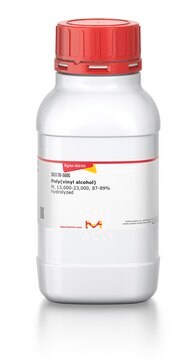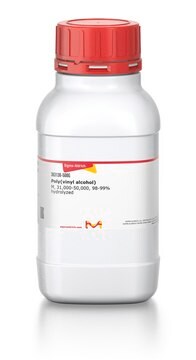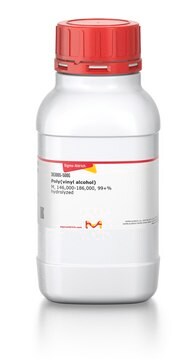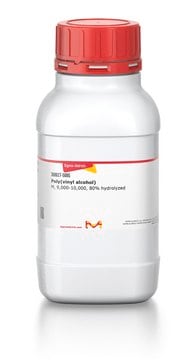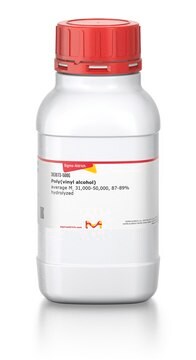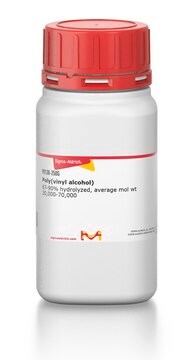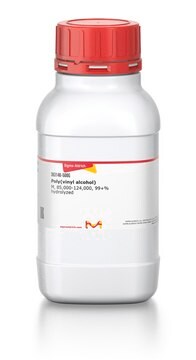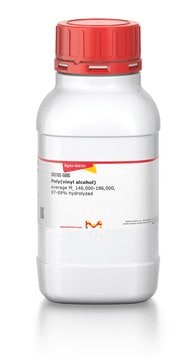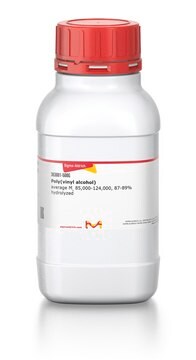348406
Poly(vinyl alcohol)
average Mw 13,000-23,000, 98% hydrolyzed
Synonym(s):
PVA
Sign Into View Organizational & Contract Pricing
All Photos(2)
About This Item
Linear Formula:
[-CH2CHOH-]n
CAS Number:
MDL number:
UNSPSC Code:
12352104
NACRES:
NA.23
Recommended Products
form
powder or crystals
mol wt
average Mw 13,000-23,000
falling ball
3.5-4.5 cP, 4 % in H2O(20 °C)(lit.)
solubility
H2O: soluble
InChI
1S/C2H4O/c1-2-3/h2-3H,1H2
InChI key
IMROMDMJAWUWLK-UHFFFAOYSA-N
Looking for similar products? Visit Product Comparison Guide
Related Categories
General description
Poly(vinyl alcohol) (PVA) is a vinyl based water soluble polymer that can be used as a non-ionic surface active agent. It can also be used as a biodegradable polymer and can be incorporated in adhesives, coatings, textiles, ceramics and cosmetics. Its properties include good transparency, chemical resistance, toughness and antielectrostatic properties.
Application
PVA can be used for a variety of applications such as:
- a nanoparticle stabilizer for the surface modification of titanium surfaces
- in the preparation of an electrolyte for supercapacitors
- formation of a composite with carbon nanotubes (CNTs) for thin film devices and flexible electronics
Storage Class Code
11 - Combustible Solids
WGK
WGK 1
Flash Point(F)
No data available
Flash Point(C)
No data available
Personal Protective Equipment
dust mask type N95 (US), Eyeshields, Gloves
Certificates of Analysis (COA)
Search for Certificates of Analysis (COA) by entering the products Lot/Batch Number. Lot and Batch Numbers can be found on a product’s label following the words ‘Lot’ or ‘Batch’.
Already Own This Product?
Find documentation for the products that you have recently purchased in the Document Library.
Customers Also Viewed
Micro-patterning of nanocomposites of polymer and carbon nanotubes
Jiang L, et al.
Microelectronic Engineering, 93(1-2), 10-14 (2012)
Compostable Polymer Properties and Packaging Applications
Plastic Films in Food Packaging, 217-248 (2013)
Plastics Materials, 386-397 (1999)
Carbon nanotube nanocomposite-modified paper electrodes for supercapacitor applications
Korivi NS, et al.
Applied Nanoscience, 7(1-2), 41-45 (2017)
Surface modification of titanium surfaces through a modified oxide layer and embedded silver nanoparticles: Effect of reducing/stabilizing agents on precipitation and properties of the nanoparticles
Ferraris S, et al.
Surface and Coatings Technology, 344(6), 177-189 (2018)
Our team of scientists has experience in all areas of research including Life Science, Material Science, Chemical Synthesis, Chromatography, Analytical and many others.
Contact Technical Service
